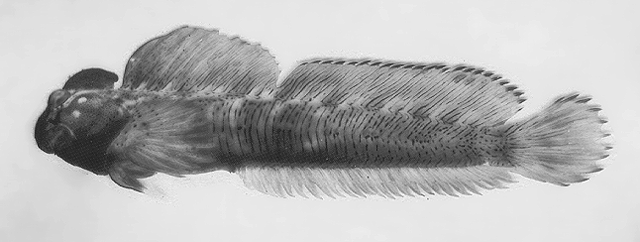| Blenniidae (Combtooth blennies), subfamily: Salariinae |
| 12 cm SL (male/unsexed) |
|
reef-associated; marine |
| Western Central Pacific. Eastern Central Pacific: Marquesan Islands (Ref. 41656). |
|
Dorsal spines (total): 13-13; Dorsal soft rays (total): 23-24; Anal spines: 2-2; Anal soft rays: 26-26. Freely movable teeth around 300 in upper jaw and 250 in lower jaw; crenulate lip margins; absence of fleshy disc behind lower lip; short and unbranched supraorbital cirrus; absence of nuchal cirri; males with fleshy occipital crest; body depth at origin of anal fin ca 7-8 SL; deep notch between spinous and soft ray portions of dorsal fin, the last ray joined by membrane to caudal peduncle; last anal ray and peduncle not bound by membrane; male coloration gray-brown, ventrally blending to white, with white vertical rows of white striations reaching dorsal fin parallel with spines and rays; a series of small, dark brown spots running along the back and continuing into dorsal-fin base; head finely dotted with white, turning white on branchiostegal membranes; a curving black line behind eye; cheek with 2 small black spots; caudal and soft dorsal ray tips white. Dorsal rays XIII, 23-24; 13 unbranched caudal rays (Ref. 54980). |
| Found in surge-zone (Ref. 54980). Oviparous. Eggs are demersal and adhesive (Ref. 205), and are attached to the substrate via a filamentous, adhesive pad or pedestal (Ref. 94114). Larvae are planktonic, often found in shallow, coastal waters (Ref. 94114). Feeds on filamentous algae (Ref. 89972). |
|
Least Concern (LC); Date assessed: 23 March 2009 Ref. (130435)
|
| harmless |
Source and more info: www.fishbase.org. For personal, classroom, and other internal use only. Not for publication.

